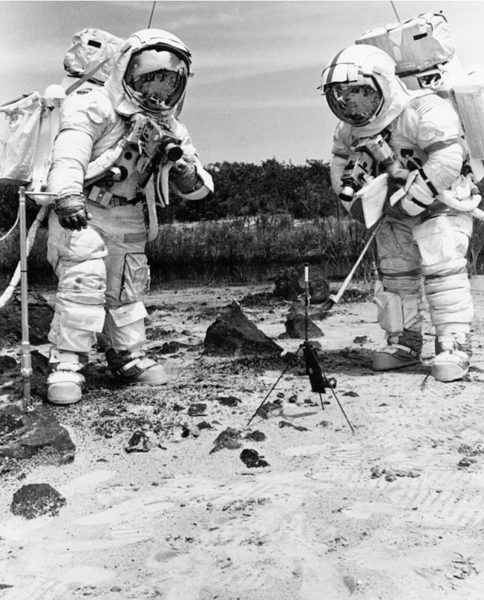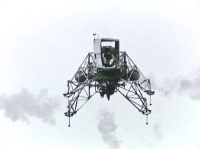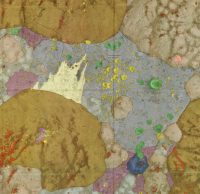
In den Kurzlinks habe ich es schon erwähnt, aber ich habe das Gefühl, dass ein ganzer Beitrag dazu fällig ist: der Apollo-17-Astronaut Harrison H. Schmitt, der als letzter Mensch auf dem Mond war, veröffentlicht nach und nach ein Tagebuch dieses Erlebnisses. Es besteht aus ausführlichen NASA-Transkripten, ergänzt durch akribisch annotierte persönliche Erinnerungen. Daraus entsteht ein so genauer Eindruck von den Vorbereitungen, Gedanken und Emotionen rund um einen Mondflug wie ich ihn noch nicht gesehen habe.
Berichte von Weltraumerlebnissen aus erster Hand fand ich schon immer sehr faszinierend. Nachdem ich als Kind den Film Apollo 13 gesehen habe, suchte ich nach Original-Transkripten der Kommunikation zwischen der Crew und Houston, um sie aus niederen Beweggründen (Spannung und Grusel) nachzulesen. Und nachdem im Fernsehen Dana Rangas Dokumentarfilm über Story Musgrave (Astronaut, Künstler, ’space person‘) lief, in dem dieser erzählt, was es mit einem macht in der Schwerelosigkeit zu schlafen oder die Erde durch das Fenster eines Shuttles zu sehen, kaufte ich mir eine Kopie direkt von der Regisseurin, um mir die Interviews nochmal ansehen zu können.
Harrisons Bericht ist realitätsnah wie die Apollo-13-Transkripte, aber auch voller schöner persönlicher Erinnerungen wie Story Musgraves Geschichten. Ich habe hier mal meine Lieblingsstellen aus den zwei bisher veröffentlichten, unglaublich langen Kapiteln 4 und 5 extrahiert (Hervorhebungen von mir).
Im vierten Kapiel „Thirty Days and Counting“ erfahren wir alles über das Training der Crew im letzten Monat vor dem Flug. Dass es schwer ist, Astronaut zu sein, habe ich mir schon gedacht, aber die physischen und psychischen Anforderungen sind hier nochmal besonders anschaulich. So fanden etwa die praktischen Übungen in irdischen Wüsten statt, und somit leider auch mit Erd-Schwerkraft und -Temperatur:
The pressure suits weighed about 80 pounds and the training backpack added another 20 pounds or so. On the Moon, the actual Portable Life Support System (PLSS) on our backs would weigh 120 Earth pounds, with the total of the two and me weighing about 370 Earth pounds…but only 62 Moon pounds. Unfortunately, we could not train in one-sixth gravity but rather had to work on a pretend lunar surface area in a back lot of the Space Center, in the central Florida sun, and move around about 270 pounds of suit, backpack, and body.
 Es kam auch ein Landevehikel zum Einsatz, das dem wirklich für die Mondlandung verwendeten ähnelte. Schmitt droppt dazu auch ein paar peinliche Anekdoten über seine Astronautenkollegen:
Es kam auch ein Landevehikel zum Einsatz, das dem wirklich für die Mondlandung verwendeten ähnelte. Schmitt droppt dazu auch ein paar peinliche Anekdoten über seine Astronautenkollegen:
Although it bore little physical resemblance to an actual Lunar Module, the LLTV was a real flight vehicle […] Two of the early flights at Ellington ended in crashes with staff pilots Algranti and Present bailing out safely. Neil Armstrong also bailed out before a third crash not long before his Apollo 11 mission to the Moon. (Armstrong returned to his office after the crash and did not bother to mention what happened to anyone. We only found out about it by word of mouth from the ops pilots.)
 Neben dem täglichen körperlichen Training müssen auch Details der Mondoberfäche gelernt werden:
Neben dem täglichen körperlichen Training müssen auch Details der Mondoberfäche gelernt werden:
By the time we entered the spacecraft for launch, we knew the features in the valley extremely well, but only within the limits imposed by the ~5 m identifying resolution and limited range of sun angles of the photographs taken of the Taurus-Littrow area by Apollo 15 and Lunar Orbiter cameras. The surprises, and there would be many, lay underneath that photographic and illumination resolution.
Über die wissenschaftlichen Ziele der einzelnen Mondlandungen wusste ich bisher nichts. Sehr interessant ist dazu z.B. der folgende Abschnitt, der erklärt, dass das Apollo-Programm zum Beweisen von Gravitationswellen beitragen sollte (die erst kürzlich mit Hilfe von kilometerlangen Messanlagen auf der Erde nachgewiesen wurden), und woran das scheiterte:
The most significant question I had during this pre-flight ALSEP deployment concerned an experiment designed to detect the „free“ oscillations (inherent vibration modes) of the Moon as a single large body in space. This Lunar Surface Gravimeter basically consisted of a very long period seismometer. If the whole Moon, very low frequency-free oscillations occurred simultaneously with free oscillations observed by seismometers on Earth, it would prove the existence of gravity waves moving through space. […] My question for Dr. Weber and his team, however, was „Have you tested the release (uncaging) of the instrument’s balance beam on an inclined plane to simulate the Moon’s one-sixth gravity?“
„No, we have not,“ was the reply.
„Why not?“
„It would reveal proprietary information owned by the manufacturer,“ was the surprising response.
In spite of the hectic training schedule at the time, I should have followed through on this question. Subsequent events on the Moon (Chapters 10, 12), when the instrument balance beam would not fully uncage, made my not following through something I regret to this day.
Besonders voyeuristisch-spannend sind auch kleine Anekdoten, etwa über Begegnungen, die einem das Astronauten-Dasein ermöglicht…
[T]he office staff interrupted us during another of Lew Hartzell’s great breakfasts with „Hey, guys, we have a call from the President for you!“ We gathered around a speakerphone in the dining room to have a conversation with a President of the United States – my first. […]
„Hello,“ greeted President Nixon. […]
„I was just thinking that this is the last of the Moon landings, but it is not the least because its gotta be the best.“ […]
„Thank you, Mr. President,“ acknowledged Cernan. „As you hang up here, we wish you God Speed in your next four years. And we look forward to a super four years…“
„We got a few little problems. We will try to work this Vietnam thing out. It will come out in the end. It will take a little more time, but it will work out. And, anyway, we will try to do as well here as you do there.
…oder über netten weihnachtlichen Quatsch:
Also, a mid-December visit to Dover in 1971 led to the purchase of a local cedar Christmas tree for a friend in Houston who grew up in this region. Unfortunately, three days after arriving in Houston, all the needles of this originally beautiful cedar fell off. This unfortunate event puzzled me for a while until I realized that, flying at 40,000 feet, the tree had been exposed to temperatures as low as minus 60°F in the exterior baggage pod of the T-38! Although bringing a Christmas tree to Houston was a cool thought, it was not one of the smartest moves in my flying career, to say the least.
Ein netter Zug von Schmitt ist auch, dass er bei allem, was passiert, immer auch die Menschen im Sinn hat, die im Hintergrund beteiligt sind und z.B. die Raumanzüge herstellen. Interessant ist bei dieser Mission auch, dass alle Beteiligten ihr Bestes geben, obwohl sie wissen, dass das Ende des Apolloprogramms und damit auch ihre Entlassung kurz bevorsteht.
The space suits had been made by the wonderful and dedicated seamstresses of the International Latex Corporation (ILC) at its plant in Dover, Delaware. […] As my Tennessee, farm-raised mother was an accomplished seamstress, I understood a lot about the challenges they faced in fabricaur suits from rubber, aluminized Mylar, and Nomex (fiberglass) ‚fabrics‘. […]
With an hour to go, the three men of the last Apollo crew to attempt to land on the Moon lay inside America, both alone and not alone. Nearly half a million Americans put us in this position and thousands still watched over us — the planners, the designers, the builders, the test teams, the trainers, the support teams and, finally, the launch and flight controllers. Tangible and intangible expressions of their patriotism, spirit, ingenuity, courage, and stamina enclosed and sustained us. Even though thousands would see their jobs eliminated as we lifted off for the Moon, not one failed us.
Schließlich naht der Tag des Abflugs zum Mond, beschrieben im fünften Kapitel „Thirty Seconds and Counting“. Für mich unvorstellbar, wie man so eine Aufregung überleben kann, die ich mir wie eine Kombination aus tausendfachem Reisefieber und Fahrprüfungsangst mit recht hohem Todesrisiko vorstelle. Die Apollo-17-Crew übersteht das mit erstaunlicher Gelassenheit, obwohl der Countdown bei 30 Sekunden nochmal für Stunden angehalten werden muss.
T-minus 30 seconds…we have a cutoff, we have a cutoff at T-minus 30 seconds. We are standing by at the T-minus 30 second mark. We’ll bring word to you just as soon as we get it. The problem was with the Terminal Countdown Sequencer, which failed to give the command to…pressurize the third stage LOX [liquid oxygen] tank.
The plan now is to recycle to the T minus 22-minute mark in the countdown. […]
This night of December 6, 1972, the minutes turned into hours and we waited. Midnight came and it was December 7th in Florida — but still no final word. […]
So, everything related to the launch of Apollo 17 was cycled back to the T minus 22-minute point in the countdown sequence. Cernan finally seemed to relax, Evans chatted and hummed away, and I took a nap.
Und schließlich meine Lieblingsmomente: wie es ist, die Erde zum ersten Mal vom Weltall aus zu sehen, zum ersten Mal Schwerelosigkeit zu spüren und zum ersten Mal aufgrund von Weltraum-Euphorie jede Professionalität zu verlieren :
Even though we watched the computer displays and mission timer count us down to S-IVB shutdown, sudden weightlessness came as a complete surprise. No weight! Weightlessness no longer existed as a fleeting memory of a childhood carnival ride or the few tens of seconds during parabolic training flights in a KC-135 ‚vomit comet‘. Now the sensation went on and on! […]
„Okay. You ready for some more [checklist items]?„
„Yes. No. Watch the sunrise,“ Cernan recommended.
„There it comes!“ I called to Evans.
„I want to watch the sunrise,“ demanded Evans.
„It’s going to come right into my eyes. …That’s the [problem with looking,]“ I said, laughing.
„Here it comes…Ka-boom!“ shouted Evans.
„Take a look at it!“ Cernan would repeat several times.
„Whooee!“
„Oh-ooh!“
„Take a look at it!“
„Look at that blaze!“
„Pow!“
„Wow!“
„Take a look at it!“
„Dammit, yes!“
„Ohh, that’s bright!“
„Yes, sir. Is that nice or not?“
„Oh, it’s just orange!“ Evans began summarize his impressions. „You know. It starts out orange and then…becomes bright; and now it looks like a…“
„Okay,“ Cernan asserted, finally. „Now go check your optics out because if they’re no good, I’m going to throw you out the hatch!“ […]„Get the optics, first,“ Cernan interjected. This was a good call, and I should not have interrupted Evans in his work in the LEB.
„Let me get the optics work, okay?“ Evans changed his mind, after Cernan’s order.
“Get that [optics] cover off!” Cernan emphasized.
„Yes, I’m going to do that; [get that cover] off,“ replied a chastised Evan. „Hot diggity dog!“
Misunderstanding this expression from Evans, Cernan asked, „Did it go?“
Back in his own world, Evans said, „I can’t believe we’ve made it up here.“
„Did it go?“ Cernan repeated.
„Ha, ha!“
„Did it go?“
„What?“ Evans finally paid attention to the question.
„The optics?“
„I don’t know. I haven’t done it yet,“ Evans informed us, laughing. It almost seemed as if Evans was euphoric over this new experience and had lost some of the focus we were used to during mission simulations.
Ha ha, pow wow! Ich kann eigentlich auch nicht glauben, dass das jemand geschafft hat, aber es macht mir unheimlich viel Spaß, das so hautnah nachlesen/-erleben zu können.
(Bildquellen: NASA-Fotos, alle entnommen aus Apollo 17: diary of the 12th man)
Der Kommandant von Apollo 17 hat vor dem Einsteigen zum Abflug vom Mond mit den Füßen den Namen seiner kleinen Tochter T(H)ERESA in den Mondstaub geschrieben – ich habe diesen interessanten Bericht vor etlichen Jahren in einer Ausgabe der Zeitschrift GEO gelesen, die in einer Arztordination aufgelegt war, aber ich traute mich nicht, sie mitzunehmen, und dann beim nächsten Arztbesuch war sie leider nicht mehr da… Da ich mir keine Notizen dazu gemacht habe (Jahrgang, Heftnummer), kann ich auch hierzu keine Hinweise geben, aber in einem Bericht zum 30-Jahr-Jubiläum der Mondfahrt habe ich in einer TV-Aufzeichnung gesehen, wie der Kommandant der Landefähre beim Hingehen zum Mondmodul Schritte gemacht hat, die wie ein „Tanz“ ausgesehen haben, und dabei wird er wohl den Mädchennamen „hingeschrieben“ haben – er hat, laut Bericht, später bedauert, kein Foto davon vor dem Einsteigen von diesem Namen gemacht zu haben. Schade!
Meine Frage an alle Interessierten, die meinen Kommentar hier lesen:
Kennt jemand diese Ausgabe der Zeitschrift GEO und kann den Jahrgang und die Nummer nennen? Es würde mir sehr viel bedeuten!
DANKE! Mag. Gerhard Mayer, Puchberg am Schneeberg, Österreich
Die Tochter von Cernan heißt Tracy, nicht Theresa. Die Story stimmt aber.
Just before the lunar module was set to leave the Moon’s surface, Cernan dropped to one knee and used his finger to carefully etch the letters “TDC” (his daughter Tracy’s initials) into the dust, where it will likely remain for the better part of a million or so years.